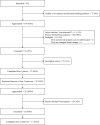Patterns and Predictors of Referral for Screening Breast MRI: A Mixed-Methods Study
- PMID: 38484303
- PMCID: PMC11238842
- DOI: 10.1089/jwh.2023.0557
Patterns and Predictors of Referral for Screening Breast MRI: A Mixed-Methods Study
Abstract
Introduction: Women with ≥20% lifetime breast cancer risk can receive supplemental breast cancer screening with MRI. We examined factors associated with recommendation for screening breast MRI among primary care providers (PCPs), gynecologists (GYNs), and radiologists. Methods: We conducted a sequential mixed-methods study. Quantitative: Participants (N = 72) reported recommendations for mammogram and breast MRI via clinical vignettes describing hypothetical patients with moderate, high, and very high breast cancer risk. Logistic regressions assessed the relationships of clinician-level factors (gender, specialty, years practicing) and practice-level factors (practice type, imaging facilities available) with screening recommendations. Qualitative: We interviewed a subset of survey participants (n = 17, 17/72 = 24%) regarding their decision-making about breast cancer screening recommendations. Interviews were audio-recorded, transcribed, and analyzed with directed content analysis. Results: Compared with PCPs, GYNs and radiologists were significantly more likely to recommend breast MRI for high-risk (ORs = 4.09 and 4.09, respectively) and very-high-risk patients (ORs = 8.56 and 18.33, respectively). Qualitative analysis identified two key phases along the clinical pathway for high-risk women. Phase 1 was "identifying high-risk women," which included three subthemes (systems for risk assessment, barriers to risk assessment, scope of practice issues). Phase 2 was "referral for screening," which included three subthemes (conflicting guidelines, scope of practice issues, legal implications). Frequency of themes differed between specialties, potentially explaining findings from the quantitative phase. Conclusions: There are significant differences between specialties in supplemental breast cancer screening recommendations. Multilevel interventions are needed to support identification and management of women with high breast cancer risk, particularly for PCPs.
Keywords: breast cancer; cancer screening; early detection of cancer; magnetic resonance imaging; preventive care.
Similar articles
-
Barriers and facilitators to breast cancer screening among high-risk women: a qualitative study.Breast Cancer Res Treat. 2025 Jan;209(1):61-71. doi: 10.1007/s10549-024-07471-y. Epub 2024 Aug 27. Breast Cancer Res Treat. 2025. PMID: 39190231
-
Breast Cancer Screening Practices for High-Risk Women: A Cross-Sectional Survey of Primary Care Providers.J Womens Health (Larchmt). 2020 May;29(5):686-692. doi: 10.1089/jwh.2018.7463. Epub 2019 Aug 21. J Womens Health (Larchmt). 2020. PMID: 31433260 Free PMC article.
-
Supplemental Screening as an Adjunct to Mammography for Breast Cancer Screening in People With Dense Breasts: A Health Technology Assessment.Ont Health Technol Assess Ser. 2023 Dec 19;23(9):1-293. eCollection 2023. Ont Health Technol Assess Ser. 2023. PMID: 39364436 Free PMC article.
-
Mammography Screening Practices in Average-Risk Women Aged 40-49 Years in Primary Care: A Comparison of Physician and Nonphysician Providers in Minnesota.J Womens Health (Larchmt). 2020 Jan;29(1):91-99. doi: 10.1089/jwh.2018.7436. Epub 2019 Jul 16. J Womens Health (Larchmt). 2020. PMID: 31314684 Free PMC article.
-
Predictors of screening for breast, cervical, colorectal, and prostatic cancer among community-based primary care practices.J Am Board Fam Pract. 2000 Jan-Feb;13(1):1-10. doi: 10.3122/jabfm.13.1.1. J Am Board Fam Pract. 2000. PMID: 10682879 Review.
Cited by
-
Acceptability and perceptions of personalised risk-based cancer screening among health-care professionals and the general public: a systematic review and meta-analysis.Lancet Public Health. 2025 Feb;10(2):e85-e96. doi: 10.1016/S2468-2667(24)00278-0. Lancet Public Health. 2025. PMID: 39909697 Free PMC article.
-
Barriers and facilitators to breast cancer screening among high-risk women: a qualitative study.Breast Cancer Res Treat. 2025 Jan;209(1):61-71. doi: 10.1007/s10549-024-07471-y. Epub 2024 Aug 27. Breast Cancer Res Treat. 2025. PMID: 39190231
References
MeSH terms
Grants and funding
LinkOut - more resources
Full Text Sources
Medical


